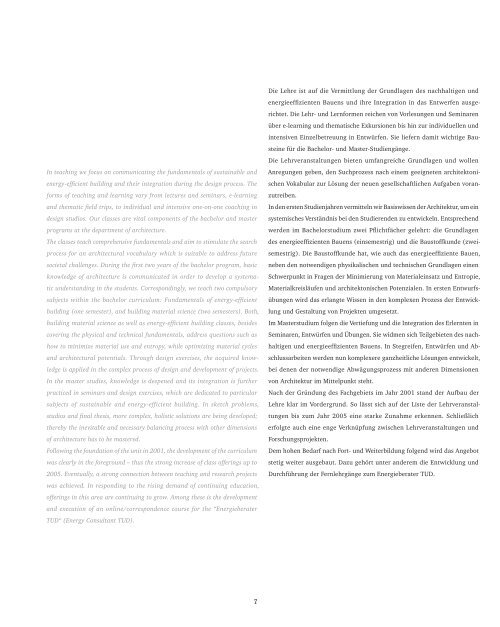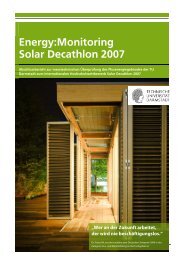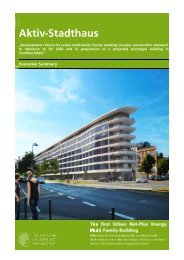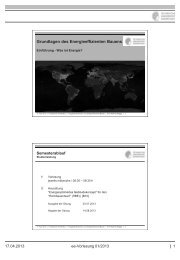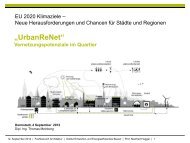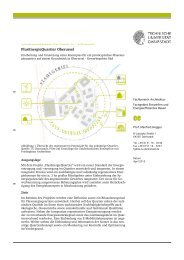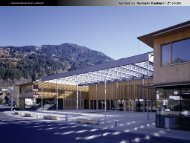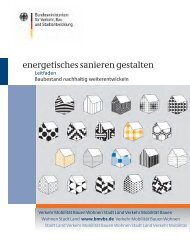110824 rz_broschure EE 237x297.indd - Entwerfen und ...
110824 rz_broschure EE 237x297.indd - Entwerfen und ...
110824 rz_broschure EE 237x297.indd - Entwerfen und ...
Sie wollen auch ein ePaper? Erhöhen Sie die Reichweite Ihrer Titel.
YUMPU macht aus Druck-PDFs automatisch weboptimierte ePaper, die Google liebt.
In teaching we focus on communicating the f<strong>und</strong>amentals of sustainable and<br />
energy-efficient building and their integration during the design process. The<br />
forms of teaching and learning vary from lectures and seminars, e-learning<br />
and thematic field trips, to individual and intensive one-on-one coaching in<br />
design studios. Our classes are vital components of the bachelor and master<br />
programs at the department of architecture.<br />
The classes teach comprehensive f<strong>und</strong>amentals and aim to stimulate the search<br />
process for an architectural vocabulary which is suitable to address future<br />
societal challenges. During the first two years of the bachelor program, basic<br />
knowledge of architecture is communicated in order to develop a systema-<br />
tic <strong>und</strong>erstanding in the students. Correspondingly, we teach two compulsory<br />
subjects within the bachelor curriculum: F<strong>und</strong>amentals of energy-efficient<br />
building (one semester), and building material science (two semesters). Both,<br />
building material science as well as energy-efficient building classes, besides<br />
covering the physical and technical f<strong>und</strong>amentals, address questions such as<br />
how to minimize material use and entropy, while optimizing material cycles<br />
and architectural potentials. Through design exercises, the acquired know-<br />
ledge is applied in the complex process of design and development of projects.<br />
In the master studies, knowledge is deepened and its integration is further<br />
practiced in seminars and design exercises, which are dedicated to particular<br />
subjects of sustainable and energy-efficient building. In sketch problems,<br />
studios and final thesis, more complex, holistic solutions are being developed;<br />
thereby the inevitable and necessary balancing process with other dimensions<br />
of architecture has to be mastered.<br />
Following the fo<strong>und</strong>ation of the unit in 2001, the development of the curriculum<br />
was clearly in the foregro<strong>und</strong> – thus the strong increase of class offerings up to<br />
2005. Eventually, a strong connection between teaching and research projects<br />
was achieved. In responding to the rising demand of continuing education,<br />
offerings in this area are continuing to grow. Among these is the development<br />
and execution of an online/correspondence course for the “Energieberater<br />
TUD“ (Energy Consultant TUD).<br />
7<br />
Die Lehre ist auf die Vermittlung der Gr<strong>und</strong>lagen des nachhaltigen <strong>und</strong><br />
energieeffizienten Bauens <strong>und</strong> ihre Integration in das <strong>Entwerfen</strong> ausge-<br />
richtet. Die Lehr- <strong>und</strong> Lernformen reichen von Vorlesungen <strong>und</strong> Seminaren<br />
über e-learning <strong>und</strong> thematische Exkursionen bis hin zur individuellen <strong>und</strong><br />
intensiven Einzelbetreuung in Entwürfen. Sie liefern damit wichtige Bau-<br />
steine für die Bachelor- <strong>und</strong> Master-Studiengänge.<br />
Die Lehrveranstaltungen bieten umfangreiche Gr<strong>und</strong>lagen <strong>und</strong> wollen<br />
Anregungen geben, den Suchprozess nach einem geeigneten architektoni-<br />
schen Vokabular zur Lösung der neuen gesellschaftlichen Aufgaben voran-<br />
zutreiben.<br />
In den ersten Studienjahren vermitteln wir Basiswissen der Architektur, um ein<br />
systemisches Verständnis bei den Studierenden zu entwickeln. Entsprechend<br />
werden im Bachelorstudium zwei Pflichtfächer gelehrt: die Gr<strong>und</strong>lagen<br />
des energieeffizienten Bauens (einsemestrig) <strong>und</strong> die Baustoffk<strong>und</strong>e (zwei-<br />
semestrig). Die Baustoffk<strong>und</strong>e hat, wie auch das energieeffiziente Bauen,<br />
neben den notwendigen physikalischen <strong>und</strong> technischen Gr<strong>und</strong>lagen einen<br />
Schwerpunkt in Fragen der Minimierung von Materialeinsatz <strong>und</strong> Entropie,<br />
Materialkreisläufen <strong>und</strong> architektonischen Potenzialen. In ersten Entwurfs-<br />
übungen wird das erlangte Wissen in den komplexen Prozess der Entwick-<br />
lung <strong>und</strong> Gestaltung von Projekten umgesetzt.<br />
Im Masterstudium folgen die Vertiefung <strong>und</strong> die Integration des Erlernten in<br />
Seminaren, Entwürfen <strong>und</strong> Übungen. Sie widmen sich Teilgebieten des nach-<br />
haltigen <strong>und</strong> energieeffizienten Bauens. In Stegreifen, Entwürfen <strong>und</strong> Ab-<br />
schlussarbeiten werden nun komplexere ganzheitliche Lösungen entwickelt,<br />
bei denen der notwendige Abwägungsprozess mit anderen Dimensionen<br />
von Architektur im Mittelpunkt steht.<br />
Nach der Gründung des Fachgebiets im Jahr 2001 stand der Aufbau der<br />
Lehre klar im Vordergr<strong>und</strong>. So lässt sich auf der Liste der Lehrveranstal-<br />
tungen bis zum Jahr 2005 eine starke Zunahme erkennen. Schließlich<br />
erfolgte auch eine enge Verknüpfung zwischen Lehrveranstaltungen <strong>und</strong><br />
Forschungsprojekten.<br />
Dem hohen Bedarf nach Fort- <strong>und</strong> Weiterbildung folgend wird das Angebot<br />
stetig weiter ausgebaut. Dazu gehört unter anderem die Entwicklung <strong>und</strong><br />
Durchführung der Fernlehrgänge zum Energieberater TUD.


